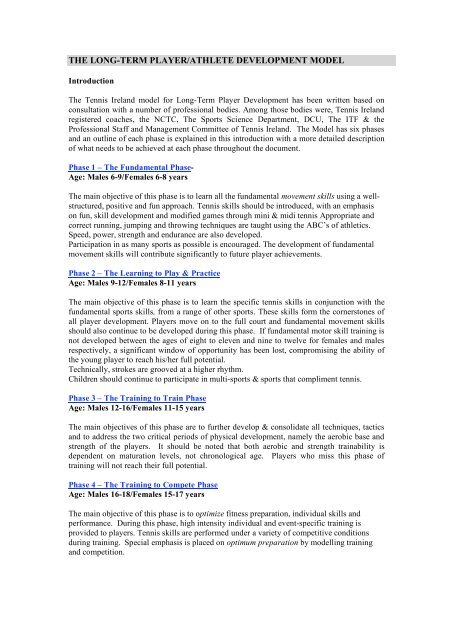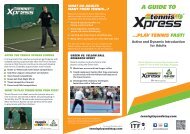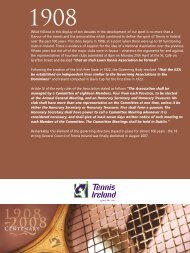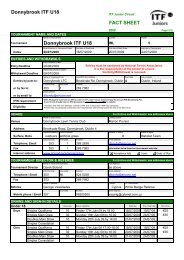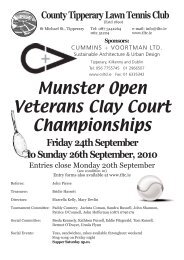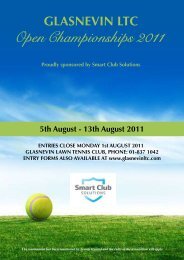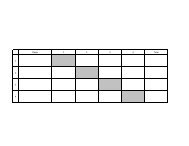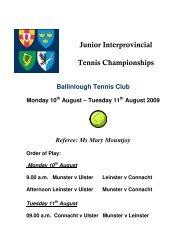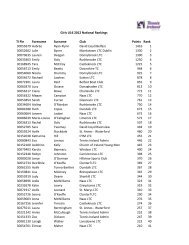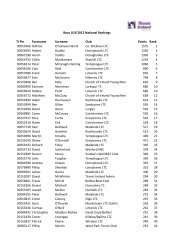the long-term player/athlete development model - Tennis Ireland
the long-term player/athlete development model - Tennis Ireland
the long-term player/athlete development model - Tennis Ireland
You also want an ePaper? Increase the reach of your titles
YUMPU automatically turns print PDFs into web optimized ePapers that Google loves.
THE LONG-TERM PLAYER/ATHLETE DEVELOPMENT MODEL<br />
Introduction<br />
The <strong>Tennis</strong> <strong>Ireland</strong> <strong>model</strong> for Long-Term Player Development has been written based on<br />
consultation with a number of professional bodies. Among those bodies were, <strong>Tennis</strong> <strong>Ireland</strong><br />
registered coaches, <strong>the</strong> NCTC, The Sports Science Department, DCU, The ITF & <strong>the</strong><br />
Professional Staff and Management Committee of <strong>Tennis</strong> <strong>Ireland</strong>. The Model has six phases<br />
and an outline of each phase is explained in this introduction with a more detailed description<br />
of what needs to be achieved at each phase throughout <strong>the</strong> document.<br />
Phase 1 – The Fundamental Phase-<br />
Age: Males 6-9/Females 6-8 years<br />
The main objective of this phase is to learn all <strong>the</strong> fundamental movement skills using a wellstructured,<br />
positive and fun approach. <strong>Tennis</strong> skills should be introduced, with an emphasis<br />
on fun, skill <strong>development</strong> and modified games through mini & midi tennis Appropriate and<br />
correct running, jumping and throwing techniques are taught using <strong>the</strong> ABC’s of athletics.<br />
Speed, power, strength and endurance are also developed.<br />
Participation in as many sports as possible is encouraged. The <strong>development</strong> of fundamental<br />
movement skills will contribute significantly to future <strong>player</strong> achievements.<br />
Phase 2 – The Learning to Play & Practice<br />
Age: Males 9-12/Females 8-11 years<br />
The main objective of this phase is to learn <strong>the</strong> specific tennis skills in conjunction with <strong>the</strong><br />
fundamental sports skills, from a range of o<strong>the</strong>r sports. These skills form <strong>the</strong> cornerstones of<br />
all <strong>player</strong> <strong>development</strong>. Players move on to <strong>the</strong> full court and fundamental movement skills<br />
should also continue to be developed during this phase. If fundamental motor skill training is<br />
not developed between <strong>the</strong> ages of eight to eleven and nine to twelve for females and males<br />
respectively, a significant window of opportunity has been lost, compromising <strong>the</strong> ability of<br />
<strong>the</strong> young <strong>player</strong> to reach his/her full potential.<br />
Technically, strokes are grooved at a higher rhythm.<br />
Children should continue to participate in multi-sports & sports that compliment tennis.<br />
Phase 3 – The Training to Train Phase<br />
Age: Males 12-16/Females 11-15 years<br />
The main objectives of this phase are to fur<strong>the</strong>r develop & consolidate all techniques, tactics<br />
and to address <strong>the</strong> two critical periods of physical <strong>development</strong>, namely <strong>the</strong> aerobic base and<br />
strength of <strong>the</strong> <strong>player</strong>s. It should be noted that both aerobic and strength trainability is<br />
dependent on maturation levels, not chronological age. Players who miss this phase of<br />
training will not reach <strong>the</strong>ir full potential.<br />
Phase 4 – The Training to Compete Phase<br />
Age: Males 16-18/Females 15-17 years<br />
The main objective of this phase is to optimize fitness preparation, individual skills and<br />
performance. During this phase, high intensity individual and event-specific training is<br />
provided to <strong>player</strong>s. <strong>Tennis</strong> skills are performed under a variety of competitive conditions<br />
during training. Special emphasis is placed on optimum preparation by <strong>model</strong>ling training<br />
and competition.
Phase 5 – The Training to Win Phase<br />
Age: Males 18+/Females 17+ years<br />
This final phase of <strong>player</strong> preparation aims to maximize fitness preparation and individual<br />
skills as well as performance. All of <strong>the</strong> <strong>player</strong>’s capacities are now fully established and<br />
<strong>player</strong>s are trained to peak for major competitions. Training is characterized by high intensity<br />
and relatively high volume with frequent periods of rest.<br />
Phase 6 – The Retirement / Retention Phase<br />
This phase refers to <strong>the</strong> activities performed after a <strong>player</strong> has retired from competition<br />
permanently. The aim of this phase is to retain <strong>player</strong>s for coaching, sport administration,<br />
officiating or any o<strong>the</strong>r sport-related career.<br />
FUNDAMENTAL PHASE: Males 6-9 / Females 6-8 years<br />
TECHNICAL CAPACITIES<br />
Mini <strong>Tennis</strong> (6-7 years)<br />
1 General:<br />
1.1 Simple and correct ready position<br />
1.2 Simple strokes<br />
1.3 Balance<br />
1.4 Judging and responding to ball trajectories<br />
2 Grips:<br />
Forehand<br />
2.1 Continental - semi continental<br />
One hand backhand<br />
2.2 Continental<br />
Double hand backhand<br />
2.3 Right hand in continental and left hand in forehand eastern.<br />
Forehand and backhand volley<br />
2.4 Eastern for forehand and continental for backhand<br />
3 Strokes:<br />
Forehand and Backhand<br />
3.1 Straight & short preparation<br />
3.2 Emphasise forward and upward movement<br />
3.3 Impact in front and to <strong>the</strong> side at a comfortable distance from body<br />
3.4 Ball judgement & anticipation.<br />
Forehand and Backhand Volleys<br />
3.5 Blocking <strong>the</strong> ball in front with racket head above wrist level.<br />
Serve:<br />
3.6 Underarm serve without a bounce/ block serve<br />
4 O<strong>the</strong>r:<br />
4.1 Modified skills of different sports<br />
4.2 Knowledge of <strong>the</strong> basics of equipment<br />
4.3 Use of appropriate footwear and clothing<br />
Midi <strong>Tennis</strong> (8 – 9 years)<br />
5 General:<br />
5.1 Balance – head still, trunk straight, solid base, low position.<br />
5.2 Low ready position.
5.3 Early ball judgement<br />
6 Grips:<br />
Ready position<br />
6.1 Should be with forehand grip.<br />
Forehand<br />
6.2 Semi continental and eastern.<br />
Double hand backhand<br />
6.3 Right hand in continental and left hand in eastern / to semi western forehand.<br />
One hand backhand<br />
6.4 Progress from continental to eastern backhand.<br />
Forehand & backhand volleys<br />
6.5 Slight grip change on ei<strong>the</strong>r side.<br />
Serve<br />
6.6 Long continental with fingers spread in trigger position.<br />
7 Strokes:<br />
Forehand & Backhand<br />
7.1 Turn shoulders from ready position, slightly widening <strong>the</strong> preparation,<br />
7.2 Footwork during preparation with small steps adjusting to <strong>the</strong> position of <strong>the</strong> ball<br />
7.3 Body weight on back leg,<br />
7.4 Most of <strong>the</strong> time straight stance however open stance is acceptable as <strong>long</strong> as it is not<br />
frontal<br />
7.5 Step forward making sure <strong>the</strong> timing of <strong>the</strong> shift of <strong>the</strong> body weight from <strong>the</strong> back to <strong>the</strong><br />
front leg is correct<br />
7.6 Impact should be firm, at a comfortable distance to <strong>the</strong> side and in front of <strong>the</strong> body<br />
7.7 The stroke should have all <strong>the</strong> components of balance<br />
7.8 Forward and upward racket work<br />
7.9 Longer follow through as a result of <strong>the</strong> more accelerated stroke<br />
Forehand specific<br />
7.10 Loop shape or pendulum shape<br />
7.11 Follow through different depending on <strong>the</strong> tactical goal<br />
Double hand backhand<br />
7.12 Mostly straight preparation but loop or pendulum is also acceptable<br />
7.13 Trunk rotation towards impact<br />
7.14 No crossing over in footwork<br />
7.15 Firm impact at a comfortable distance in front and to <strong>the</strong> side with both hands working<br />
toge<strong>the</strong>r<br />
One hand backhand<br />
7.16 Wider loop or pendulum preparation<br />
7.17 Forearm close to stomach<br />
7.18 No trunk rotation, later body rotation<br />
7.19 Firm contact with <strong>the</strong> arm stretching out towards <strong>the</strong> contact at a comfortable distance to<br />
<strong>the</strong> side and in front<br />
7.20 Left arm a little back on <strong>the</strong> follow through<br />
Forehand & backhand volleys<br />
7.21 Block volleys<br />
7.22 When in control of <strong>the</strong> situation, push or punch ball away from opponent<br />
7.23 Step towards <strong>the</strong> ball and slightly rotate trunk with <strong>the</strong> racket going forward and<br />
downward.
Serve<br />
7.24 Correct grip<br />
7.25 Correct starting position<br />
7.26 Correct co-ordination of spreading arms & bending legs in preparation<br />
7.27 Small push upwards in <strong>the</strong> legs<br />
7.28 Fluent swing<br />
7.29 High contact<br />
7.30 Balanced with no jump<br />
7.31 Follow through as a natural end of movement with arm toward stomach.<br />
Lob<br />
7.32 Playing <strong>the</strong> ball upward<br />
7.33 Control of forward upward action of <strong>the</strong> arm.<br />
Smash<br />
7.34 Preparation with <strong>the</strong> face of <strong>the</strong> racket towards <strong>the</strong> back of <strong>the</strong> head<br />
7.35 Free hand up towards <strong>the</strong> ball<br />
7.36 High impact<br />
7.37 Quick footwork.<br />
Return<br />
7.38 Footwork and correct position<br />
7.39 No specific techniques at this phase<br />
TACTICAL CAPACITIES<br />
8 General<br />
8.1 Modified games<br />
9 Serve:<br />
9.1 Starting <strong>the</strong> point with firstly underarm and <strong>the</strong>n over arm serve<br />
9.2 Control and placement<br />
10 Return:<br />
10.1 Getting <strong>the</strong> ball back<br />
10.2 Getting <strong>the</strong> ball back deep<br />
10.3 Attack off short ball<br />
11 Both Back:<br />
11.1 Basic positioning on <strong>the</strong> court<br />
11.2 Consistency (rally situations)<br />
11.3 Moving <strong>the</strong> ball out of <strong>the</strong> middle - accuracy<br />
11.4 Introduce <strong>the</strong> concept of unbalancing <strong>the</strong> opponent<br />
11.5 Using fh in 3/4 court<br />
11.6 Receiving high /low deep/short balls<br />
11.7 Slow speed of ball should be encouraged for control at <strong>the</strong> start<br />
12 Opponent Approaches:<br />
12.1 Use pass or lob<br />
13 When Approaching:<br />
13.1 On balls that are short approach <strong>the</strong> net<br />
13.2 Basic positioning at <strong>the</strong> net (angles <strong>the</strong>ory)<br />
PHYSICAL CAPACITIES<br />
14 General<br />
14.1 Practise and mastery of fundamental movement skills (running, jumping, throwing)<br />
14.2 General overall <strong>development</strong> and mobility<br />
15 Stamina (Endurance)<br />
15.1 Endurance through FUN games<br />
15.2 Endurance through varied games
15.3 Endurance on and off <strong>the</strong> court<br />
15.4 Developed through o<strong>the</strong>r sports and tennis games<br />
16 Strength<br />
16.1 Strength training using own-body weight, medicine ball and physio ball exercises<br />
17 Speed<br />
17.1 Linear, lateral and multi-directional speed using low volume, short duration (< 5 secs)<br />
session with work:rest ratio of 1:5<br />
18 Skill<br />
18.1 Develop agility, balance, co-ordination and speed (ABC’s)<br />
18.2 KGBs of movement such as kines<strong>the</strong>sia, gliding, buoyancy and striking (racquet with<br />
ball)<br />
18.3 Cks of catching kicking and striking (with a body part, gaelic, hurling)<br />
19 Suppleness (Flexibility)<br />
19.1 Dynamic stretching instead of static stretching during warm-up<br />
MENTAL CAPACITIES<br />
20 Perceptions of Ability<br />
20.1 Players perceive <strong>the</strong> mastery of basic technical and tactical skills<br />
20.2 Confidence in executing basic technical and tactical skills<br />
21 Intrinsic Motivation<br />
21.1 Inherent enjoyment and interest of <strong>the</strong> game is fostered through enjoyable tennis<br />
specific exercises, mastery of <strong>the</strong> game and supportive training environment<br />
22 Self-Esteem<br />
22.1 Development of self-esteem through an emphasis on learning/personal improvement in<br />
a supportive/team environment<br />
23 Autonomy/Personal Performance Enhancement<br />
23.1 Develop positive thinking through group activities and tennis specific games and<br />
exercises<br />
24 Relaxation<br />
24.1 Learn skills to relax through games and activities<br />
25 Imagery<br />
25.1 Learn to create images through games<br />
26 Concentration<br />
26.1 Develop concentration skills through focusing activities<br />
27 Teamwork<br />
27.1 Teamwork<br />
LIFESTYLE CAPACITIES<br />
28 Involvement in multi-sports<br />
29 Learn safety<br />
PERSONAL CAPACITIES<br />
30 Enjoyment/Fun<br />
31 Fair Play<br />
32 Positive Attitude<br />
33 Teamwork/interaction skills<br />
Top
LEARNING TO PLAY & PRACTICE: Males 9-12 / Females 8-11 years<br />
TECHNICAL CAPCITIES<br />
34 General:<br />
34.1 Grooving <strong>the</strong> strokes at a higher rhythm<br />
34.2 Introduce <strong>the</strong> basics of special strokes<br />
34.3 Sharpening control with an emphasis on placement and <strong>the</strong> optimal zone of impact<br />
34.4 Special attention should continue to be given to <strong>the</strong> ready position, which should be just<br />
in front of or behind <strong>the</strong> baseline<br />
34.5 The correct footwork at all times<br />
34.6 Early reaction<br />
34.7 Taking <strong>the</strong> ball on <strong>the</strong> rise as often as possible (impact)<br />
34.8 Balance on each stroke<br />
35 Grips:<br />
Forehand<br />
35.1 Eastern or semi-western<br />
Backhand-Double Handed<br />
35.2 Left hand in eastern forehand and right hand in continental for impacts at hip height<br />
35.3 Left hand and right hand in eastern forehand for higher impacts and bigger accelerations<br />
Backhand-Single Handed<br />
35.4 Eastern for impacts at hip height and full eastern for higher impacts<br />
Volleys<br />
35.5 Grip towards height of impact – continental to eastern<br />
Serve<br />
35.6 Long continental with finger spread in trigger position<br />
36 Strokes:<br />
Forehand<br />
36.1 Forward and upward emphasis as a source of power<br />
36.2 Extra ground force reaction and extra rotation required<br />
36.3 All impacts on <strong>the</strong> rise as often as possible<br />
36.4 On <strong>the</strong> rotation, stay in <strong>the</strong> same place<br />
36.5 Back foot and back shoulder come forward<br />
36.6 Develop <strong>the</strong> use of spin<br />
36.7 Closed stance (no crossover). Open stance is ok if not too frontal<br />
36.8 Good balance<br />
One hand backhand<br />
36.9 Also extra up and extra rotation, less as in forehand.<br />
36.10 Good balance<br />
36.11 A lot more co-ordination required to execute <strong>the</strong> skill<br />
Two hand backhand<br />
36.12 Better possibilities to play on <strong>the</strong> rise<br />
36.13 Also up extra up and extra rotation, more than one handed backhand<br />
36.14 Preparation shorter and higher<br />
36.15 Higher impact<br />
36.16 Good balance<br />
36.17 Adapting <strong>the</strong> size of <strong>the</strong> preparation to <strong>the</strong> situation<br />
Backhand Slice<br />
36.18 Use of body weight more forward<br />
36.19 Timing brining <strong>the</strong> right foot forward<br />
Volleys
36.20 Perfecting <strong>the</strong> technique towards <strong>the</strong> height of impact and <strong>the</strong> type of ball received –<br />
Block, Push, Punch<br />
36.21 Control should be good<br />
Serve<br />
36.22 Demand <strong>the</strong> correct grip<br />
36.23 Develop <strong>the</strong> upward emphasis from a stand still position and later with leaving <strong>the</strong><br />
ground<br />
36.24 Good toss<br />
36.25 Most of <strong>the</strong> time starting and finishing on <strong>the</strong> left foot<br />
36.26 Second serve with slice and a little lift<br />
36.27 Control during matches<br />
Smash<br />
36.28 Maintain as in previous phase<br />
36.29 More control<br />
36.30 Response to different trajectories<br />
Approach<br />
36.31 Correct footwork<br />
Lob<br />
36.32 Control of height and length<br />
36.33 Being able to play various trajectories<br />
Additional skills<br />
36.34 Rough forms of backhand slice, return, passing shot, half volley, drive volley, backhand<br />
smash should be developed and encouraged during reply without looking for perfect<br />
outcomes<br />
TACTICAL CAPCITIES<br />
37 Serve:<br />
37.1 Use of A.B.C serves<br />
37.2 Start to use topspin second serve<br />
37.3 Using aggressive play after <strong>the</strong> serve<br />
38 Return:<br />
38.1 Return with depth and accuracy<br />
38.2 Begin to use forehand to take control of weak second serves<br />
38.3 Use forehand to take control of weak second serves<br />
39 Both Back:<br />
39.1 Grooving good diagonals and when to come out of <strong>the</strong>m<br />
39.2 Good depth<br />
39.3 Use of angles to open <strong>the</strong> court with good acceleration<br />
39.4 Court positioning<br />
39.5 Starting to play more on <strong>the</strong> rise<br />
39.6 Train offensive and defensive situations<br />
39.7 Building strengths<br />
39.8 Starting to analyse opponents and play on different surfaces<br />
39.9 Varying <strong>the</strong> rhythm in situations<br />
40 Opponent Approaches:<br />
40.1 Use angle pass, cross or line<br />
40.2 Use lob in certain situations<br />
41 When Approaching:<br />
41.1 Use slice to approach off backhand side<br />
41.2 Use forehand drive approach<br />
41.3 Positioning around <strong>the</strong> net<br />
PHYSICAL CAPACITIES<br />
42 General
42.1 Warm-up, stretching and cool-down routine<br />
42.2 Skill, speed, strength and suppleness should be fur<strong>the</strong>r developed by structured<br />
sequenced training 80% training to 20% competition<br />
43 Stamina<br />
43.1 Continue to develop endurance through FUN games<br />
44 Strength<br />
44.1 Develop strength using medicine ball, swiss/physio ball and own-body exercises as well<br />
as hopping-bounding exercises<br />
45 Speed<br />
45.1 Reaction speed, linear speed, footwork speed, multi-directional speed up to 5 seconds<br />
46 Skill<br />
46.1 Continue to develop agility, balance, coordination and speed<br />
47 Suppleness<br />
47.1 Basic flexibility exercises during warm-up, Developmental stretching after training<br />
MENTAL CAPACITIES<br />
48 Perceptions of Ability<br />
48.1 Confidence in adjusting to different rhythms and all types of serves<br />
48.2 Perceives significant improvement in technique<br />
49 Intrinsic Motivation<br />
49.1 Continued emphasis on learning and self-improvement in a supportive, co-operative<br />
learning environment<br />
50 Self-Esteem<br />
50.1 Development of self-esteem through an emphasis on learning/personal involvement<br />
51 Autonomy/Personal Performance Enhancement<br />
51.1 Introduction to personal monitoring (logbooks, self-talk)<br />
51.2 Develop an awareness of how thoughts are linked to on-court behaviour<br />
51.3 Introduction to structured goal-setting<br />
51.4 Introduction to match plans<br />
51.5 Introduction to match analysis<br />
51.6 Understands <strong>the</strong> role of practice, warm-up and warm-down routines<br />
52 Relaxation<br />
52.1 Understands <strong>the</strong> importance of breathing for on-court control and relaxation<br />
52.2 Group relaxation exercises incorporated into warm-up/warm-down<br />
53 Imagery<br />
53.1 Introduction to <strong>the</strong> concept of <strong>model</strong>ling on and off court<br />
54 Concentration<br />
54.1 Focusing in <strong>the</strong> face of distractions<br />
54.2 Shifting focus<br />
54.3 Activities that emphasise <strong>the</strong> importance of <strong>the</strong> ‘here and now’ element of<br />
performance<br />
55 Teamwork<br />
55.1 Teamwork<br />
LIFESTYLE CAPACITIES<br />
56 Involvement in multi-sports<br />
57 Inclusion of sport in lifestyle<br />
58 Participation in complementary sports<br />
PERSONAL CAPACITIES<br />
59 Understand <strong>the</strong> changes puberty will bring<br />
60 Accept discipline and structure<br />
61 Understand <strong>the</strong> relationship between effort and outcome
62 Teamwork/interaction skills<br />
63 Motivation to participate<br />
Top<br />
TRAINING TO TRAIN: Males 12-16 / Females 11-15 years<br />
TECHNICAL CAPACITIES<br />
64 General:<br />
64.1 Fur<strong>the</strong>r develop and consolidate all techniques<br />
64.2 Fluent rhythm<br />
64.3 Ability to adjust to different rhythms<br />
64.4 Increasing <strong>the</strong> capacity to accelerate<br />
64.5 Improving footwork to perfection<br />
64.6 Individualising techniques and bringing <strong>the</strong>m to perfection<br />
64.7 All strokes and spins should be known<br />
64.8 There should be sound technique that can be trained to develop weapons<br />
64.9 Technique should be tailored to suit <strong>the</strong> body of <strong>the</strong> <strong>player</strong><br />
64.10 Power tennis should be possible from all areas of <strong>the</strong> court<br />
64.11 Optimal use of <strong>the</strong> ground force reaction power and rotation speed<br />
64.12 Playing on <strong>the</strong> rise should be perfected.<br />
65 Strokes:<br />
65.1 Perfect grooving of <strong>the</strong> consolidated forms of forehand, backhand, forehand & backhand<br />
volley, smash, lob, approach, serve, return & passing shot.<br />
Forehand & Backhand<br />
65.2 At <strong>the</strong> early stage building up power tennis with control<br />
65.3 Extra rotation required<br />
Approach<br />
65.4 Consistency and placement<br />
65.5 Winners<br />
65.6 All different techniques for approach<br />
High half court ball – Forehand<br />
65.7 Impact more on <strong>the</strong> rise<br />
65.8 Open stance<br />
65.9 Extra rotation and move on to net.<br />
High half court ball – Backhand<br />
65.10 Jump from front foot to front foot.<br />
Low half court ball – Forehand<br />
65.11 Bring back foot forward or move on with open stance<br />
Low half court ball – Backhand<br />
65.12 Bring back foot forward.<br />
Backhand slice<br />
65.13 Tango step<br />
65.14 Run around backhand to use <strong>the</strong> forehand weapon.<br />
65.15 Fur<strong>the</strong>r develop <strong>the</strong> use of spin in order to increase <strong>the</strong> tactical possibilities.<br />
65.16 Forehand & backhand volley, lob, smash, approach and passing shot – all combinations<br />
and control should be good and should be developed fur<strong>the</strong>r towards perfection in end of<br />
<strong>the</strong> phase.
Serve<br />
65.17 Upward emphasis should be well developed<br />
65.18 Starting and finishing on front foot, less and less crossing over<br />
65.19 No preference for bringing back foot close to front foot or keeping back foot back<br />
65.20 Towards <strong>the</strong> end of <strong>the</strong> phase <strong>the</strong> technique should be producing power<br />
65.21 Extra rotation in preparation with back to net<br />
65.22 Active bending in <strong>the</strong> legs<br />
65.23 Extra rotation in stroke<br />
65.24 A lot of attention to 2 nd serve and slice serve should be developed with consistency and<br />
control<br />
65.25 Towards <strong>the</strong> end of <strong>the</strong> phase <strong>the</strong> 2 nd serve should be very strong<br />
65.26 The slice should be brought to perfection<br />
65.27 Placement should be very accurate.<br />
Return<br />
65.28 Ready position on or just behind base line, second serve mostly closer<br />
65.29 Emphasize forward movement if possible, staying if necessary, but avoid going<br />
backwards<br />
65.30 Split step, just before impact of opponents serve<br />
65.31 Impact more towards open stance even on backhands<br />
65.32 Ability to place <strong>the</strong> ball depending on <strong>the</strong> opponent’s possibilities when he approaches<br />
after serve or stays back<br />
65.33 Aggressive on 2 nd serve return mostly on fh<br />
65.34 Automation of <strong>the</strong> correct forms of backhand slice, High Volley, Drive Volley, Drop<br />
Shot & Backhand Smash.<br />
65.35 Practicing <strong>the</strong> above in closed and open situations and encouraging <strong>the</strong>ir use in matches.<br />
65.36 Much more open situations on return to involve anticipation<br />
TACTICAL CAPACITIES<br />
66 Serve:<br />
66.1 Serve and big forehand patterns<br />
66.2 Serve and volley patterns<br />
66.3 Have all three types of second serves (slice, kick and flat)<br />
67 Return:<br />
67.1 Anticipation on returns<br />
67.2 Return with depth and accuracy<br />
67.3 Use forehand to take control of weak second serves<br />
68 Both Back:<br />
68.1 Developing more dominating game style<br />
68.2 Good depth<br />
68.3 Use of angles to open <strong>the</strong> court with good acceleration<br />
68.4<br />
More advance court positioning, trying to take control of <strong>the</strong> baseline<br />
68.5 The difference between artificial grass and hard / clay courts<br />
68.6 Dominating from <strong>the</strong> mid court<br />
68.7 Train offensive and defensive situations<br />
68.8 Develop individual game style<br />
68.9 Analyse opponents and play on different surfaces<br />
68.10<br />
Varying <strong>the</strong> rhythm in situations, varying <strong>the</strong> height speed and spin of <strong>the</strong> ball<br />
68.11 Begin to use flair in points and set up situations to train this<br />
68.12 Learn how to design strategy
68.13 Use video analysis of match play with match chart<br />
69 Opponent Approaches:<br />
69.1 Use angle pass cross or line<br />
69.2 Understand concept of two shot pass<br />
69.3 Use lob in certain situations<br />
70 When Approaching:<br />
70.1 Use slice to approach off backhand side<br />
70.2 Use forehand drive approach<br />
70.3 Use sneak approach and drive volley<br />
PHYSICAL CAPACITIES<br />
71 Stamina<br />
71.1 Aerobic training prioritised after onset of Peak Height Velocity (PHV)<br />
72 Strength<br />
72.1 Strength training should be done 2/3 times per week for not more than 30 mins<br />
72.2 Strength training prioritised in females after PHV and with <strong>the</strong> onset of menarche<br />
72.3 Strength training prioritised in males 12-18 months after PHV<br />
72.4 Proper weight lifting techniques should be learned<br />
Start free weight training earlier with those who have onset of peak height velocity<br />
earlier<br />
72.5 Frequent musculoskeletal evaluations during PHV<br />
73 Speed<br />
73.1 Interval training should be introduced to females in <strong>the</strong> first part of this stage and males<br />
in <strong>the</strong> second part.<br />
73.2 Linear, lateral and multi directional movement speed need to be trained<br />
73.3 Speed should be done all year round and at <strong>the</strong> beginning of a lesson after <strong>the</strong> warm up.<br />
74 Skill<br />
74.1 Continue to develop agility, balance, coordination and speed<br />
75 Suppleness<br />
75.1 Shoulder, elbow, core, spine and ankle stability<br />
75.2 Static stretching and proprioceptive neuromuscular faciliation should be complemented<br />
by active isolated stretching when required<br />
75.3 Stretching sessions separate to on court work is recommended at this stage<br />
75.4 Dynamic mobility and rehabilitation routines should replace static stretching in warm<br />
ups<br />
MENTAL CAPACITIES<br />
76 Perceptions of Ability<br />
76.1 Develop <strong>player</strong>s belief in <strong>the</strong>ir ability by emphasising a focus on self-improvement in<br />
fitness, technical and tactical skills<br />
77 Intrinsic Motivation<br />
77.1 Continued emphasis on learning and self-improvement in a supportive, co-operative<br />
learning environment (i.e. technical and tactical improvement)<br />
78 Self-Esteem<br />
78.1 Player understands and accepts that self-worth is not linked to performance
79 Autonomy/Personal Performance Enhancement<br />
79.1 Understanding of personal game style<br />
79.2 Match analysis<br />
79.3 Match plans<br />
79.4 Independent mistake detection and correction<br />
79.5 Goal-setting (process, performance and <strong>long</strong>-<strong>term</strong> outcome goals)<br />
79.5 Goals centred around <strong>development</strong> of technical, physical and psychological skills<br />
79.6 Self-talk: cognitive reframing<br />
79.7 Understands <strong>the</strong> concept of deliberate practice<br />
80 Relaxation<br />
80.1 Explores different relaxation techniques and incorporates <strong>the</strong>se into performance and<br />
pre-performance routines<br />
81 Imagery<br />
81.1 Imagery for practising and improving technique and o<strong>the</strong>r technical aspects<br />
81.2 Imagery for general motivation and improving self-confidence<br />
82 Concentration/Control<br />
82.1 On court/off court – <strong>player</strong> beings to develop during performance and pre-performance<br />
routines (i.e. begins to develop between point mechanism to refocus due to lapses in<br />
concentration/control)<br />
82.2 Understands <strong>the</strong> link between lapses in concentration and performance<br />
82.3 Continued emphasis on focusing on ‘here and now’<br />
82.4 Arousal control: <strong>player</strong> beings to get a sense of how arousal levels are linked to<br />
performance<br />
83 Teamwork<br />
83.1 Teamwork<br />
LIFESTYLE CAPACITIES<br />
84 Nutrition / hydration advice<br />
85 Training and performance diary/log<br />
86 Time management<br />
87 Introduction to planning and periodisation<br />
88 Rest and recovery<br />
89 Well laid out training, competition and recovery programme to optimise <strong>the</strong> various<br />
training effects<br />
PERSONAL CAPACITIES<br />
90 Interpersonal skills and learning to work in team environment<br />
91 Positive communication<br />
92 Discipline and personal responsibility<br />
93 Awareness of Peak Height Velocity and windows of trainability<br />
94 Creative thinking<br />
95 Commitment to improve/achieve goals<br />
96 Personal responsibility<br />
Top
TRAINING TO COMPETE: Males 16-18 / Females 15-17 years<br />
TECHNICAL CAPACITIES<br />
97 General:<br />
97.1 The most important work has been done<br />
97.2 Work on improving <strong>the</strong> efficiency of <strong>the</strong> different strokes<br />
97.3 Use of good combinations<br />
97.4 More precision and speed on one’s strengths<br />
97.5 Stabilising one’s weaknesses and learning how to hide <strong>the</strong>m<br />
97.6 Individualisation of skills – ‘personal style’<br />
97.7 Optimising <strong>the</strong> individualisation of techniques in relation to different situations and<br />
court surfaces<br />
97.8 Adjusting ones self to <strong>the</strong> different wea<strong>the</strong>r conditions.<br />
97.9 Consistency and control<br />
97.10 Competition simulation training<br />
98 Strokes:<br />
98.1 Adjusting all techniques to <strong>the</strong> individual game style<br />
Base line strokes<br />
98.2 Better and more variation in power in all situations.<br />
Volley<br />
98.3 Tactical control on powerful shots.<br />
Approach<br />
98.4 Perfect timing on <strong>the</strong> stroke and with use of body weight and recovery<br />
98.5 Optimal use of building up <strong>the</strong> rallies according to one’s own game style.<br />
Lob<br />
98.6 Bringing <strong>the</strong> defensive and offensive lob to perfection<br />
98.7 Topspin lob on <strong>the</strong> run<br />
Smash<br />
98.8 Should be a powerful winner<br />
Serve<br />
98.9 First and second serve should be very strong<br />
98.10 The second serve should have a lot of variation, not only on backhand<br />
TACTICAL CAPACITIES<br />
99 Serve:<br />
99.1<br />
Serve and big forehand patterns<br />
99.2 Serve and volley patterns<br />
99.3 Fur<strong>the</strong>r develop % on <strong>the</strong>se patterns<br />
99.4 Have all three types of second serves (slice, kick and flat)<br />
100 Return:<br />
100.1 Anticipation on returns<br />
100.2 Return with depth and accuracy<br />
100.3 Taking control of <strong>the</strong> point from a weak second serve<br />
100.4 High % of time during training on this, on all surfaces<br />
101 Both Back:<br />
101.1 Become more familiar with own game style<br />
101.2 Use strengths and avoid weaknesses<br />
101.3 Use of angles to open <strong>the</strong> court with good acceleration<br />
101.4 Fur<strong>the</strong>r develop decision making and link with game style
101.5 Use individual flair<br />
101.6 Train offensive and defensive situations<br />
101.7 Fur<strong>the</strong>r develop individual game style<br />
101.8 Analyse opponents and play on different surfaces<br />
101.9<br />
Varying <strong>the</strong> rhythm in situations, varying <strong>the</strong> height speed and spin of <strong>the</strong> ball<br />
101.10 Know tactics to use against different game styles<br />
101.11 Learn how to design strategy<br />
101.12 Use video analysis of match play with match chart<br />
101.13 Training a lot on slower courts with high bounces<br />
102 Opponent Approaches:<br />
102.1 Use angle pass cross or line<br />
102.2 Understand concept of two shot pass<br />
102.3 Use lob in certain situations<br />
103 When Approaching:<br />
103.1 Use forehand drive approach<br />
103.2 Use sneak approach and drive volley<br />
PHYSICAL CAPACITIES<br />
104 General<br />
104.1 Individual specific intensive physical conditioning<br />
104.2 Optimum preparation: tapering and peaking<br />
105 Stamina<br />
105.1 Maintenance training and more attention to specific endurance training<br />
106 Strength<br />
106.1 Light bar bells after growth spurt, develop large muscle<br />
106.2 Specific tennis jumps, throwing drill<br />
107 Speed<br />
107.1 Speed maintenance – extra attention to reaction speed and tennis specific speed<br />
107.2 Speed training should be done on <strong>the</strong> court<br />
108 Suppleness<br />
108.1 Joint mobilisation in warm up and static stretching after training<br />
108.2 Shoulder, elbow, core, spine and ankle stability<br />
MENTAL CAPACITIES<br />
109 Perceptions of Ability<br />
109.1 Player’s belief in ability developed through refinement of technique, improved<br />
tactical understanding and competitive performance<br />
110 Intrinsic Motivation<br />
110.1 Continued emphasis on fostering intrinsic motivation<br />
111 Self-Esteem<br />
111.1 Player understands <strong>the</strong> accepts self-worth is not linked to performance<br />
112 Autonomy/Personal Performance Enhancement<br />
112.1 Refining pre and during performance routines<br />
112.2 Goal setting – short <strong>term</strong> and <strong>long</strong> <strong>term</strong> goals<br />
112.3 Match plans<br />
112.4 Match analysis<br />
112.5 Mistake detection and correction<br />
112.6 Understands <strong>the</strong> importance of deliberate practice of psychological skills<br />
113 Relaxation<br />
113.1 Player individualises and refines his/her relaxation techniques<br />
114 Imagery
114.1 Imagery now incorporates tactical elements of <strong>the</strong> game and problem solving<br />
114.2 Imagery for general motivation and improving self-confidence<br />
115 Concentration<br />
115.1 Continued emphasis in ‘here and now’<br />
115.2 Simulation training<br />
116 Coping Skills<br />
116.1 Coping with parental pressure, fear of failure, travel<br />
117 Teamwork<br />
117.1 Teamwork<br />
LIFESTYLE CAPACITIES<br />
118 Individualisation of ancillary supports<br />
119 Refined self-monitoring<br />
120 Plan career/sport options<br />
121 Increased knowledge on hydration and nutrition<br />
122 Preparation for different environments e.g. heat / cold / rain / altitude<br />
123 Injury prevention and recovery<br />
124 Learn how to handle jet lag and cope with extended travel and different diets<br />
125 Diagnostic tests to identify individual needs in <strong>player</strong>s<br />
126 Dealing with social problems e.g. alcohol culture, peer pressure, school, jobs etc.<br />
127 Develop a support network<br />
128 Awareness of scholarships<br />
129 Time management, academic/tennis balance<br />
PERSONAL CAPACITIES<br />
130 Continued personal <strong>development</strong><br />
131 Integration of tennis, career and life goals<br />
132 Economic and independence issues addressed<br />
133 Understanding of importance of deliberate practice of psychological skills as well as<br />
o<strong>the</strong>r skills<br />
Top<br />
TRAINING TO WIN: Males 18 + / Females 17 + years<br />
TECHNICAL CAPACIITES<br />
134 Complete refinement of sports specific skills.<br />
135 Event-/competition-specific training skills are automatic/second nature<br />
136 Ability to improvise with skills<br />
TACTICAL CAPACITIES<br />
137 Serve:<br />
137.1 Serve and big forehand patterns<br />
137.2 Serve and volley patterns<br />
137.3 Fur<strong>the</strong>r develop % on <strong>the</strong>se patterns<br />
138 Return:<br />
138.1 Anticipation on returns<br />
138.2 Return with depth and accuracy<br />
138.3 Taking control of <strong>the</strong> point from a weak second serve<br />
139 Both Back:<br />
139.1 Have developed solid game style<br />
139.2 Use strengths and avoid weaknesses within <strong>the</strong> game style<br />
139.3 Use of angles to open <strong>the</strong> court with good acceleration
139.4 Fur<strong>the</strong>r develop decision making and link with game style<br />
139.5 Use individual flair<br />
139.6 Train offensive and defensive situations<br />
139.7 Control <strong>the</strong> rally with fast play<br />
139.8 Analyse opponents and play on different surfaces<br />
139.9<br />
Varying <strong>the</strong> rhythm in situations, varying <strong>the</strong> height speed and spin of <strong>the</strong> ball<br />
139.10 Know tactics to use against different game styles<br />
139.11 Make strategy for different types of <strong>player</strong>s<br />
139.12 Use video analysis of match play with match chart<br />
140 Opponent Approaches:<br />
140.1 Use angle pass cross or line with precision or power<br />
140.2 Understand concept of two shot pass<br />
140.3 Use lob in certain situations<br />
141 When Approaching:<br />
141.1 Approach at appropriate times (depending on game style)<br />
141.2 Use forehand drive approach<br />
141.3 Use sneak approach and drive volley<br />
141.4 Taking control of <strong>the</strong> point from a weak second serve<br />
PHYSICAL CAPACITIES<br />
142 General<br />
142.1 All aspects individualised<br />
142.2 Frequent prophylactic (preventative breaks)<br />
143 Stamina<br />
143.1 Maintenance and prioritise if necessary<br />
144 Strength<br />
144.1 Maintenance and prioritise if necessary<br />
145 Speed<br />
145.1 Maintenance and prioritise if necessary<br />
146 Suppleness<br />
146.1 Maintenance<br />
MENTAL CAPACITIES<br />
147 Automaticity<br />
147.1 Well-developed, refined and individualised mental skills and routines (i.e.<br />
concentration, relaxation, refocusing, pre-performance and performance routines)<br />
148 Autonomy/Personal Performance Enhancement<br />
148.1 Goal setting (short and <strong>long</strong>-<strong>term</strong> goals)<br />
148.2 Match analysis<br />
148.3 Match plans<br />
148.4 Mistake detection and correction<br />
149 Intrinsic Motivation<br />
149.1 Continued emphasis on self-improvement<br />
150 Imagery<br />
150.1 Imagery incorporating tactics, problem-solving, pre-performance routines and during<br />
performance routines<br />
151 Concentration<br />
151.1 Simulation training<br />
151.2 Continued monitoring of lapses in concentration and linking to performance outcomes<br />
152 Teamwork<br />
152.1 Teamwork<br />
LIFESTYLE CAPACITIES<br />
153 Increased knowledge on all areas
154 Rest and relaxation.<br />
155 Frequent breaks<br />
156 Well developed self-monitoring<br />
157 Well developed and integrated support network/structure<br />
158 Career/sport planning sustained<br />
PERSONAL CAPACITIES<br />
159 Full integration of tennis, career and life goals<br />
Top<br />
RETIREMENT/RETAINMENT<br />
TECHNICAL CAPACITIES<br />
160 Retain skills and develop new ones<br />
TACTICAL CAPACITIES<br />
161 Maintain previous developed skills<br />
162 Play more doubles<br />
PHYSICAL CAPACITIES<br />
163 Decrease loads<br />
164 Maintain good healthy habits<br />
165 Keep active through sports participation<br />
MENTAL CAPACITIES<br />
166 Importance of continued social support and physical fitness<br />
167 Relaxation<br />
168 Readjustment to non-competitive environment<br />
LIFESTYLE CAPACITIES<br />
169 Pursue personal and family goals more strongly<br />
170 Pursue fur<strong>the</strong>r education/career <strong>development</strong><br />
171 Possible engagement in administration, coaching, media/PR<br />
172 Seek transition support, if required<br />
PERSONAL CAPACITIES<br />
173 Reset goals


